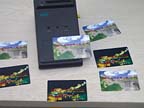News & Notes

Great Wall Adopts Technology
The Beijing Municipal Administration and Communications Card Co. Ltd. will be employing MIFARE UltraLight contactless chip technology from Royal Philips Electronics of San Jose, Calif., in a new e-ticketing system for the Great Wall of China at Badaling. No longer serving primarily as a means of keeping roving bands of horse warriors at bay, the Great Wall will use the e-ticket system to allow more convenient access for tourists.
Existing magnetic card access readers will be replaced by Philips’ contactless chip technology, which is compatible with Beijing’s existing One-Card ticketing system to be employed at the 2008 Olympics. The system also supports the mass transit cards – based on the contactless system – issued by city’s department of public transportation. Visit www.semiconductors.philips.com.
PSBTech Hosts Web-Based Access
The Monitoring Division of Professional Security Brands Technologies LLC (PSBTech) has partnered with Synergistics to host I-Access, a full feature, online, data encrypted access control system. The host servers for the system are located in the company’s UL-listed central station, equipped with redundant communications and power, and staffed around the clock by trained personnel.The company estimates that its deployment model can save more than 25 percent of the total installed costs for a typical system and as much as 60 percent of the annualized cost of ownership.
“I-Access does not require a dedicated server or software and is easily integrated with most existing systems,” said PSBTech president Doug Goode. “Data is automatically archived, software updates are automatically downloaded and the customer has the lowest total cost of ownership access control system on the market.”
Teams Who Practice Together
With sweeping national security reforms suggested by the Congressional 9/11 Terrorism Commission, many charged with protecting citizens are implementing similar provisions.Most notable: an increase in metropolitan governments conducting joint anti-terror training sessions among police, firefighters, S.W.A.T., hazmat, bomb squads and others. San Diego’s police and firefighting teams conducted a vast simulation of a nightmare scenario, incorporating simulated gun battles, defusing of mock bombs, controlling a hazardous spillage, tracking down “terrorists” fleeing the site and storming a prop building, focusing on minimizing loss of life and property and training various groups to mobilize effectively as one unit in the case of a terrorist strike.
“The level of conversation with outside agencies has certainly increased since 9/11 but we’ve always had a good continuing dialogue with the FBI,” said Dave Cohen of the San Diego Police Department.
San Diego isn’t alone in finding new ways for separate security teams to work together. Last October, Michigan and Indiana staged a mock trial concerning a fictional smallpox attack in order to shore up loopholes.
“If you had a biological threat, [such as] smallpox being spread among the community crossing state lines, we’re really going to have to work together,” said Indiana Attorney General Steve Carter. “We’re going to have to have the legal mechanisms in place to do that.”
Security Exclusive: Americans Less Concerned about Privacy
Most Americans, fearful of terrorism as well as more typical crime, do not feel their privacy is invaded by current public and private security measures, according to a new survey from ADT Security Services Inc., conducted with Security magazine.More than seven in 10 Americans surveyed feel reassured by cameras and other security measures in public places such as streets and parks, as well as those in and around private property, according to the exclusive national survey. Underscoring the concern about personal safety, less than a third of the respondents believe that their privacy is invaded by such measures as security cameras in public places and access controls.
The survey also found that six in ten Americans said that security cameras provide effective crime deterrence. Nine in 10 said that the use of these devices in airports, retail establishments and government buildings is appropriate. Seven in 10 are reassured by such precautions as home security systems, identification cards and access control badges in the workplace, and anti-shoplifting systems in stores.
“The ADT Security Survey conclusively demonstrates that the public feels safer knowing that there are extra ‘eyes’ helping to protect them in many of the places they visit throughout the day,” said Jay Stuck, vice president of corporate communications for ADT.
Fast List Includes Security Firm
Fast Company magazine has named VistaScape Security Systems of Atlanta one of 101 top ideas, trends and people that will change the way people work and live in 2005. Fast Company cited the core concept behind VistaScape – multi-sensor, single view video surveillance. “The idea is to take something reactive – the security camera – and make it an active tool for preventing crime,” the magazine editors said.Mistakes Aid Identity Theft
Despite millions of cases of identity theft every year, Americans continue to surrender too much personal information over the phone or Web, according to the 2004 Identity Management Survey. The survey, commissioned by EDS and the International Association of Privacy Professionals, and conducted by the Ponemon Institute found consumers are not practicing all security precautions to protect themselves despite repeated warnings of identity theft. And the problems are hurting many businesses.Key survey findings show that more than 70 percent of people will share information, such as their name, address, postal code, phone number, account number or give the answer to a security question to an unsolicited call or email.
The survey also gauged interest toward innovative methods of identification verification, such as biometrics and a single secure and private identification credential. Results suggest that a majority of consumers are open to alternative methods of identification management solutions.
For example, more than 69 percent are open to the idea of using biometrics for identity management. Only 12 percent said no to biometrics, while 19 percent are unsure.

Visitor IDs Hot Application
At conferences as varied as the American Society for Industrial Security international exhibition and Securing New Ground, a significant trend is upgrading of the way that organizations handle their facility visitors. The bottom line: sign-in logs are out of favor while systems that collect and maintain a database of visitors are in.An example is what happened at Macromedia, a San Francisco company with multiple buildings, six receptionists and about 350 visitors a week. It recently moved to a computer-based photo identification system for handling visitors.
Macromedia’s Facilities Manager, Andy Friend, estimated that it took upwards of two hours – an incredibly “tedious process” – just to find a single visitor record, if he could find it at all. And none of the information was accompanied by a photo, which meant that a visitor could easily transfer his or her badge to someone else, someone who hadn’t signed in.
He brought in an Avery Photo ID System (Vienna, Va.) which now guides Macromedia’s visitors through the sign-in process, ensuring that they fill in all of the required information. In addition, it takes the visitors’photo, and stores them along with the visitors’ data. Before installing the system, Macromedia recorded visitor information manually for each building, which only complicated the process of tracking visitors. Now, that the system runs on its existing network, Macromedia’s facilities manager can track data not just for each individual building, but for all of them combined through the centralized digital log.
If a job candidate has interviews in each of Macromedia’s three buildings, that information is captured in one consolidated record that is always quickly accessible. And, as Macromedia’s facilities manager points out, “People come in, they enter their information. Yes, they could enter in a fake name, but their picture is taken, and we hold on to that record. That’s a phenomenal leap forward in terms of our visitor mangement.”

Armored Vehicles Gain
International research reports from business and government groups suggest that security executives are purchasing armored vehicles for their top officials.The DeVille Protection Series, Cadillac’s entry into the protected vehicle market, was shown at the American Society for Industrial Security show and is designed to meet the security needs of high profile individuals requiring luxury and personal protection as they travel.
Cadillac showcased a fleet of four armored vehicles at the show. Two of the vehicles were available to potential clients for test drives, allowing them to experience the ride and handling characteristics of the DeVille Protection Series before making a purchase decision. The other two vehicles were displayed in the Cadillac booth, where Cadillac Professional Vehicle personnel explained and demonstrated unique features to security executives from Fortune 500 companies, U.S. government agencies from the nation’s capital, and leading security consultants from around the world.
Sidebar: Most People Are Reassured by Security
Reassured (Highly to Somewhat)Security Cameras In/Around
Private Property 71%
Security Cameras in Public Places 74%
ID Cards, Badges in Workplace 70%
Electronic Tracking of Vehicles 66%
Source: Security magazine and ADT Security Services
Looking for a reprint of this article?
From high-res PDFs to custom plaques, order your copy today!


